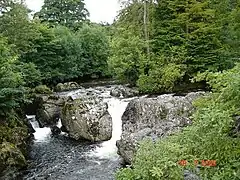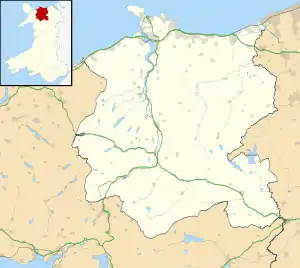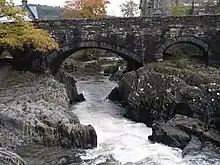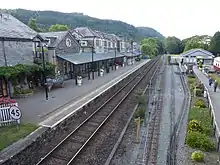Betws-y-Coed
Betws-y-coed (Welsh pronunciation: [ˈbɛtʊs ə ˈkɔɨd]) ![]() (listen); English: prayer house in the wood) is a village and community in the Conwy valley in Conwy County Borough, Wales, located in the historic county of Caernarfonshire, right on the boundary with Denbighshire, in the Gwydir Forest.
(listen); English: prayer house in the wood) is a village and community in the Conwy valley in Conwy County Borough, Wales, located in the historic county of Caernarfonshire, right on the boundary with Denbighshire, in the Gwydir Forest.
| Betws-y-coed | |
|---|---|
 Afon Llugwy | |
 Betws-y-coed Location within Conwy | |
| Population | 564 (2011 census)[1] |
| OS grid reference | SH795565 |
| Community |
|
| Principal area | |
| Ceremonial county | |
| Country | Wales |
| Sovereign state | United Kingdom |
| Post town | BETWS-Y-COED |
| Postcode district | LL24 |
| Dialling code | 01690 |
| Police | North Wales |
| Fire | North Wales |
| Ambulance | Welsh |
| UK Parliament | |
| Senedd Cymru – Welsh Parliament | |
Etymology
The first part of the name of the village comes from the Middle English word bedhus, meaning "prayer house", which became betws in Welsh.[2] Welsh: Coed translates to wood, therefore making the village Prayer House in the Wood.
Toponymy
The name Betws or Bettws is generally thought to be derived from the Anglo-Saxon Old English bed-hus—i.e. a bead-house: a house of prayer, or oratory.[3] The earliest record of the name is Betus, in 1254.[4]
Location
Betws-y-Coed is one of the honeypot locations in Snowdonia. It lies in the Snowdonia National Park, in a valley near the point where the River Conwy is joined by the River Llugwy and the River Lledr, and was founded around a monastery in the late sixth century. The village grew very slowly with the development of the local lead mining industry. In 1815, the Waterloo Bridge, built by Thomas Telford to carry the London to Holyhead road (now the A5) across the River Conwy and through the village, brought considerable transport-related development. The village became a major coaching centre between Corwen (to the east) and Capel Curig (to the west) on the Irish Mail route from London to Holyhead, which led to the improvement of the roads south to Blaenau Ffestiniog and north to Llanrwst and Conwy. It is a primary destination for the purpose of road signs.
Construction of Betws-y-Coed railway station in 1868 heralded the arrival of the railway line from Llandudno Junction railway station, and resulted in the village's population increasing by around 500.
The village has a large village green which is the playing field for the local football team. The green is bounded on its western side by the A5 trunk road, with 19th century buildings, including shops, hotels, and the Church of St Mary. This church was built on the site of a former cockpit and fairground, and although it is of early English appearance, it was completed as recently as 1873, the internal roof timbers testifying to this relatively young age. The interior also features various types of stone: local bluestone, sandstone (and floor tiles) from Ancaster, and black serpentine from Cornwall. The square bell tower was added in 1907, and the integral church hall was added in the 1970s, the commemorative stone being laid by the Earl of Ancaster in 1976.


On the southern side of the green is the railway station with cafes, tourist shops and a car park. In the former railway goods yard, reached from the station, is the Conwy Valley Railway Museum with its extensive miniature railway.
Other attractions in the village include the Miners' Bridge and the 14th century church of St. Michael, which is the origin of the name Betws (meaning "prayer-house"). There are scenic walks beside the River Llugwy, which flows through the village, and the River Conwy provides further attractions, including the Fairy Glen, the Conwy Fish pass and waterfalls including the Conwy Falls. The Pont-y-Pair Falls are in the centre of the village (also the site of a 53-hole rock cannon), and a mile upstream are the famous Swallow Falls.
The Llyn Elsi reservoir nearby is popular with walkers and anglers, and also provides water for the village. A wide range of footpaths provide access to the lake, both from Betws y Coed itself and the outlying village of Pentre Du. There are many other small lakes in the vicinity.
The village is also a centre for outdoor activities and lies within the Gwydyr Forest.
The current Betws-y-Coed Golf Club was founded in the 1970s. There was a much earlier club and course located on or near the Recreation Ground.[5]
The village is home to at least one well known rock band; Melys were founded there in 1996.
Governance
The parish, including the village itself and its immediate neighbourhood, has a population of 564.[1] An electoral ward of the name Betws-y-Coed also exists. This ward includes a large additional area including two neighbouring communities Capel Curig and Dolwyddelan and has a total population of 1,244.[6] The ward elects a county councillor to Conwy County Borough Council.
Transport

Extensive passenger and goods facilities were however provided at Betws-y-Coed. The station was built by local builder Owen Gethin Jones.[7] In the LMS timetables the station was listed as "Bettws-y-Coed - Station for Capel Curig".
References
- UK Census (2011). "Local Area Report – Betws-y-Coed Parish (W04000106)". Nomis. Office for National Statistics. Retrieved 4 January 2021.
- "0817e Geirfa Enwau Lleoedd Cymraeg. Welsh place name vocabulary. (Gwefan Cymru-Catalonia)". kimkat.org. Retrieved 30 October 2020.
- Johnston, James Brown (1915). The place-names of England and Wales. London: John Murray. p. 144. OCLC 457619292. Retrieved 29 October 2020.
- Domesday Maps website Archived 21 November 2008 at the Wayback Machine
- John Dean. "Betws-y-Coed, Conwy". Golfsmissinglinks.co.uk. Retrieved 13 December 2014.
- UK Census (2011). "Local Area Report – Betws-y-Coed Ward (W05000113)". Nomis. Office for National Statistics. Retrieved 4 January 2021.
- Jenkins, Robert Thomas. "Jones , Owen Gethin". wbo.llgc.org.uk. Dictionary of Welsh Biography. Retrieved 19 January 2015.
- Bibliography
- The A-Z of Betws-y-coed, by Donald Shaw. Gwasg Carreg Gwalch, 1990. ISBN 0-86381-153-1
External links
| Wikimedia Commons has media related to Betws-y-Coed. |
| Wikivoyage has a travel guide for Betws y Coed. |
- Chisholm, Hugh, ed. (1911). . Encyclopædia Britannica. 3 (11th ed.). Cambridge University Press.
- Betws-y-Coed Community Council official website
